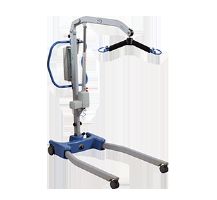 Written by Mike Price, OT
Written by Mike Price, OT
Hoyer lifts are an essential safety tool to care for patients who are unable to get out of bed or move from their wheelchairs without significant assistance. Through the use of patient slings and adjustable lifting cradles, Hoyer lifts carry a patient from nearly any surface and allow them to be moved to a stretcher, bathtub, toilet, or nearby location.
Hoyer lifts are assistive medical devices which apply specially-designed slings and pads to safely lift a patient from a bed to a wheelchair, toilet, or stretcher. These devices come in many shapes and sizes and are often categorized by the level of automation they bear, whether that’s manual or hydraulic, electric or battery-powered.
Hoyer lifts perform the crucial role of safely moving these patients from bed or place of rest while eliminating strain on the caregiver and also preventing falls due to lack of balance and muscle control.
Given the multitude of patient types for which these lifts are used, they come in a variety of shapes and sizes. Each lift bears different capabilities in weight capacity, size, cradle design, and more, in order to ensure each patient’s specific needs are met.
Hoyer lifts are a necessity for patients who are 90% - 100% incapable of getting out of bed without assistance. These patients can include the elderly, patients with leg injuries, paralyzed patients, incapacitated patients, and children with special needs.
Hoyer lifts are a cost-effective means of addressing a potentially dangerous situation. Physically moving patients when they are incapable of moving themselves leaves both caregivers and patients vulnerable to injury, and caregivers who do not use Hoyer lifts when moving patients place themselves at high risk of injuring their back and arms.
Hoyer lifts are critically important to safely transfer a patient from bed to locations such as a stretcher, a chair, or a bedside commode. Therefore, whether you are the patient or the caregiver, a Hoyer lift is essential for your safety and injury prevention.
Using a Hoyer lift can vary slightly depending on the patient’s location, whether they are in bed, a wheelchair, or another surface. However, the core steps remain the same.
The cost of a Hoyer lift typically ranges from $650 to $7,500, depending on the model, weight capacity, and whether it is manual or electric.
Many fully automated Hoyer lifts, including ceiling-mounted versions, are built for single-person use. However, a successful one-person operation depends on whether the caregiver can roll the patient onto their side to place the sling or if the patient can assist with this movement. After positioning the sling, the caregiver uses the lift's controls to elevate and move the patient, while guiding them into the intended location.
Yes, a Hoyer lift can be used on low-pile carpets. It may require more effort to move the lift due to increased friction. For thick carpets, consider using a lift with larger caster wheels for smoother mobility.
Medicare Part B may cover some or the total amount of the cost of a Hoyer lift, as it is classified under durable medical equipment (DME). However, Medicare will likely require a doctor’s prescription for the lift before they will provide any coverage.
Every private insurance policy is different, and many private insurance policies follow the lead of Medicare. However, this is not always the case. Before choosing to purchase a Hoyer lift through private insurance, look into your policy to learn exactly what degree of coverage they offer. Checking your individual coverage regarding durable medical equipment (DME) will provide the clearest answer.
We offer a wide selection of Hoyer lifts that suit different needs and budgets. Visit our Hoyer lift category to explore all of our options!
Some Hoyer lifts come equipped with a built-in scale to weigh the patient during transfers, while others require the addition of a separate scale attachment. This feature is useful for routine patient monitoring without needing additional equipment or transfers.
 | Hoyer Elevate Active Sit-to-Stand Mobile Lift with Removable Foot Tray View Product |
Standard Hoyer Lifts: Typically supports up to 400 pounds, making it suitable for most patients needing assistance with transfers. These lifts offer reliable support for a wide range of users, but it’s essential to verify weight capacity before each use.
 | Hoyer Presence Multi-Purpose Patient Lift with Powered Base View Product |
Bariatric Hoyer Lift: Designed specifically for patients over 400 pounds, bariatric Hoyer lifts feature reinforced construction to safely support heavier individuals. Given the increased weight, many manufacturers recommend opting for an electric-powered lift for bariatric patients, as these lifts reduce the physical strain on caregivers and minimize the risk of injury during transfers. It's crucial to confirm the weight capacity before purchasing, as not all Hoyer lifts are built to accommodate bariatric needs.
 | Hoyer Stature Vertical Power Lift with Clip-Style Positioning Cradle View Product |
Electric Hoyer lifts or battery-poweredlifts operate without the physical administration of the caregiver, raising and lowering at the touch of a button. While more convenient, these lifts are likely to cost more than a manual lift.
 | Hoyer HPL700 Electric Mobile Lift with Power Adjustable Base View Product |
Manual Hoyer lifts, or manual hydraulic lifts, require the administration of hand-cranking. This means the caregiver must be able to generate enough counter-leverage by building the lifting pressure manually. The caregiver must first position the patient within the lifting sling, then hand-crank the Hoyer lift to a raised position before maneuvering the patient from point A to point B.
 | Hoyer HML400 Hydraulic Manual Lift View Product |
Naturally, manual hydraulic Hoyer lifts are more physically demanding of the caregiver. However, they are considerably more cost-effective than any other type of Hoyer lift, as they do not require power. This is also advantageous in the case of maintenance because hydraulic Hoyer lifts will never require the electrical upkeep that is needed for powered lifts.
The front-facing, crane-like device to which the patient sling attaches to a lift is called the cradle. There are several common designs for cradles, but the most common difference between them is the number of attachment points they bear.
Cradles typically have two, four, or six attachment points. Generally speaking, the more attachment points on a cradle, the larger the area of patient weight distribution becomes. Depending on the patient’s specific needs, this can be a very important product decision. A six-point cradle will typically require less bending or movement from the patient than a two-point or four-point cradle will.
 | Hoyer HPL402 Mobile Power Lift with Reverse-Mounted Actuator View Product |
Hoyer lifts come in a variety of materials, but most will either be constructed with a plastic blend, a dense metal blend, or sometimes, a combination of both. Because of this, lifts tend to vary in product weight.
 | Hoyer Advance Portable Folding Patient Lift by Joerns Healthcare View Product |
The purchase of a Hoyer lift is a critical step towards safe and comfortable transfer of patients from surface to surface as well as protecting caregivers from injury. Rehabmart is here for you and your loved ones for each step of the process, whether that’s helping you research the best product for your needs or delivering it to your home.
If you're interested in exploring more about Hoyer lifts along with other wellness topics, be sure to visit our blog, Caregiver University, where we offer a wealth of resources to support your health and well-being!

Co-Founder of Rehabmart and an Occupational Therapist since 1993. Mike has spent his professional career working in multiple areas of Occupational Therapy, including pediatrics, geriatrics, hand therapy, ergonomics and inpatient / outpatient rehabilitation. Mike enjoys writing articles that help people solve complex therapeutic problems and make better product choices.